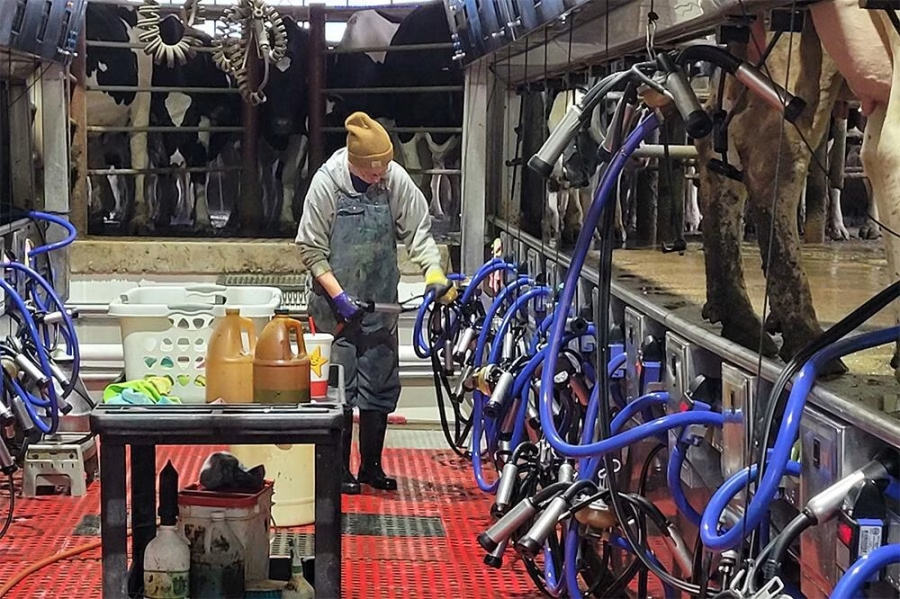Learn how stray voltage affects dairy farming and how to protect your cows. Do you know about the hidden risks to your milk production?
Summary: Have you ever wondered if something more sinister is draining your dairy farm’s profits and productivity? Dairy farmers have grappled with a hidden enemy for over five decades: stray voltage. This silent threat has devastating effects on livestock, yet its existence has been mired in lies, falsified research, and outright gaslighting. Stray voltage, undesired energy that escapes into the ground or conductive surfaces, can stem from poor wiring, insufficient grounding, and flaws in the power company’s electrical grid. For cows, it means stress, reduced milk output, lower feed intake, and a higher risk of illnesses like mastitis. Even at levels as low as 2 to 4 volts, this stress can lead cows to avoid water or feeding stations. The USDA estimates that up to 20% of dairy farms could be affected by stray voltage. Testing for stray voltage is crucial to protecting the herd and your livelihood.
- Stray voltage can severely affect livestock, resulting in stress, reduced milk production, and higher illness incidents.
- Causes of stray voltage include poor wiring, insufficient grounding, and flaws in the power company’s grid.
- Even low levels of stray voltage (0.03-0.05 volts) can make cows avoid water or feeding stations.
- The USDA estimates that up to 20% of dairy farms could be impacted by stray voltage.
- Testing for stray voltage is essential to safeguard livestock and farm profitability.

Have you ever wondered why your cows are continuously upset or why milk output changes for no apparent reason? The solution might be more inconspicuous and unexpected than stray electricity. This hidden threat has plagued dairy farms for decades. Still, the amount of disinformation, fabricated data, and blatant falsehoods surrounding it is staggering. Stray voltage reduces milk output and directly influences herd health, resulting in higher veterinary expenditures and lower earnings. “Stray voltage influences dairy cow behavior, health, and milk output. It may cause lower milk output, higher somatic cell counts, and other health issues in cows.” [Stray Voltage Facts]. For over 50 years, dairy producers have been duped with falsified statistics, deceptive research, and testing that mask the hazards. The time to act is now. Can you afford to ignore this problem any longer? Join us as we delve into the dark realm of stray voltage, unraveling the deception and revealing the truth about this industry-wide disaster.
Electrical Nightmare: How Stray Voltage Could Be Sabotaging Your Dairy Farm
Stray voltage is undesired energy that escapes into the ground or other conductive surfaces, resulting in low-level electrical currents that travel outside their intended paths. Imagine your farm’s electrical infrastructure as a garden hose. If the hose contains microscopic holes, water (or, in this instance, electricity) will leak out. This kind of leakage is known as stray voltage.
But how does it happen? Poor wiring, insufficient grounding, and malfunctioning electrical equipment are familiar sources of stray voltage. These issues allow electricity to leave its intended circuit. Another source is the power company’s electrical grid; currents may return via the ground rather than designated neutral lines, functional in rural regions with aging infrastructure.
This is very significant for dairy producers. Stray voltage may cause stress in cows, reducing milk output, lower feed intake, and greater susceptibility to illnesses like mastitis. Even at levels as low as 2 to 4 volts and 0.03 volts, the strain may lead cows to avoid water or feeding stations, jeopardizing their health and your farm’s profitability.
Stray Voltage: The Silent Saboteur of Dairy Farms
Stray voltage is more than simply an electrical annoyance; it is a quiet adversary that progressively saps the vitality of your herd and the prosperity of your dairy enterprise. Imagine entering your barn expecting to see healthy, productive cows, only to discover anxious, diseased, or dead animals and declining milk output. Unfortunately, such is the harsh truth for many farmers who have unwittingly become victims of this unseen threat.
“Our cows started showing signs of stress and unnatural behaviors,” Allan from Bert-Mar Farms remembers. “We noticed a drastic drop in milk production, and it took us years to realize stray voltage was to blame” [source: DairyStar, Inc.]. Many in the industry share this attitude, having had similar situations but failed to identify the root.
Numerous research have established the harmful effects of stray voltage on dairy cows. According to research, even tiny levels of electrical current (below 0.25mAmp) may produce behavioral changes, reduced feed intake, higher somatic cell counts, and decreased milk production. A thorough evaluation of 46 research experiments found that cows exposed to voltages as low as 1 volt saw substantial decreases in milk output and general health [source: StrayVoltageFacts].
For instance, Mary Francque, a dairy farmer who witnessed the severe impacts of stray voltage firsthand, shared, “We saw a 20% drop in milk production almost overnight.” Trying to determine what was wrong until we checked for stray electricity [source: Iowa State University] was a nightmare. Such experiences underscore the tremendous impact of stray voltage and the critical need for awareness and mitigating actions.
Cows exhibiting signs of electrical exposure, such as reluctance to enter the milking parlor, unexpected aggression, or unusual hoof and joint issues, are most likely suffering from stray voltage effects, according to studies by the Agricultural Research Service and other organizations [source: Bovine Vet Online]. These signs are often misinterpreted, resulting in prolonged animal suffering and financial losses for producers.
Stray voltage has a significant financial impact on dairy farms. Farms affected by stray voltage often report a 15-30% drop in milk output, leading to yearly losses of thousands of dollars. Moreover, the cows’ health deteriorates, and reproduction suffers, resulting in higher veterinary bills and shorter herd lifetimes. These cumulative consequences can severely impact the financial viability of both large and small dairy enterprises.
Stray voltage is a widespread problem that has plagued dairy farms for decades. Farmers like Allan and Mary’s personal stories serve as a powerful call to action. Dairy producers must become more cautious, conduct frequent inspections, and seek expert reviews to protect their businesses from this hidden threat. The good news is that stray voltage is preventable. You can safeguard your farm and livelihood with the proper knowledge and proactive measures.
Stray Voltage: Not Just a Technical Glitch, But a Financial Catastrophe
Let’s talk numbers; according to the literature review summarizing 46 research trials, groups of cows exposed to known voltage and current levels experienced significant reductions in milk yield and overall health. Lower productivity means fewer gallons shipped, which equates to lower profits. The hidden costs don’t stop there; sick cows lead to higher veterinary bills and increased labor costs to manage and mitigate these health issues.
On another note, Steve and Mary Francque’s battle with stray voltage is a poignant example. The Francques reported spending over $100,000 over a few years in an attempt to diagnose and rectify the problem. What dairy farm can carry such an enormous unexpected expense without suffering? It became a choice between investing in necessary machinery upgrades or continuously addressing the detrimental effects of stray voltage.
It’s crucial to recognize the industry-wide scale of the stray voltage problem. The USDA has estimated that up to 20% of dairy farms in any area could be affected by stray voltage. This isn’t an isolated issue; it’s an industry-wide challenge that demands serious attention. The collective financial impact could exceed millions of dollars lost in productivity and increased operational costs [source: USDA].
These examples underscore that stray voltage isn’t just an abstract problem; it’s a tangible threat to a farm’s profitability and viability. The direct and indirect costs can compound quickly, creating a financial burden that many farms may find impossible.
Decades of Deception: Unmasking the Stray Voltage Scandal in Dairy Farming
Since the 1970s, stray voltage has been a significant worry in dairy farming. The issue gained attention when farmers reported inexplicable declines in milk output and unusual behavioral changes in their herds. Based on anecdotal evidence from impacted farmers, initial inquiries were typically rejected as coincidence or owing to bad farm management techniques.
However, by the early 1980s, this contemptuous attitude had begun to shift. Studies, such as the extensive study conducted by recognized agricultural specialists (https://strayvoltagefacts.com/), have revealed a relationship between stray voltage and decreased dairy output. Despite the evidence accumulated, disinformation efforts and fraudulent studies obscured the reality. Powerful utility corporations often supported these deceptive studies to escape accountability and the financial consequences of dealing with the problem.
A famous example of such deception happened in pivotal research trials financed by the electrical industry, which controversially reduced the importance of stray voltage by altering data to indicate minor impacts on dairy cows. These trials, cited over the subsequent decades, played a significant role in shaping public perception and policy around stray voltage, effectively gaslighting the farming community (https://img1.wsimg.com/blobby/go/d719dd64-4767-4754-9681-480de02a93fe/downloads/Stray-Voltage-Injuries-in-Dairy-Farmers-A-Revi.pdf?ver=1721680466256).
By the 1990s, individual case studies and accumulating anecdotal evidence from farmers like the Burdicks, who reported devastating consequences on their cattle, had pushed the topic back into the scientific realm. Despite this, adequate identification of the problem was met with tremendous hostility, with many blaming cow health difficulties on less problematic factors.
In the past two decades, a renaissance of interest and more transparent studies have begun peeling back the obfuscation layers. Notable research, such as those reviewed in Spring 2018, has highlighted the adverse effects of stray voltage on dairy operations, supporting distressed farmers’ assertions [source](https://dairystar.com/stories/a-shock-to-the-system,24087).
The history of stray voltage awareness is rejection, disinformation, and a long march to realization. It emphasizes the necessity of openness and robust, impartial research in protecting the interests of those who feed the country.
Gaslighting in the Dairy Industry: The Hidden Truth About Stray Voltage
The dairy farming community has been subjected to unparalleled disinformation and gaslighting regarding stray voltage. How often have scientists and authorities dismissed your fears about stray voltage as “an overreaction” or “unlikely to affect your herd”? It isn’t enjoyable.
For decades, utility companies and other industry players have minimized stray voltage’s seriousness, dismissing it as a mere annoyance. Recognizing the facts would entail expensive mitigation efforts, probable responsibility, and a considerable loss to their financial line. Instead, they’ve brushed the data under the rug, leading farmers to mistrust their own experiences.
Consider the story of Mary Francque, a dairy farmer whose herd’s health deteriorated unexpectedly. “I was told repeatedly that it was all in my head, that stray voltage couldn’t possibly be causing the problems I was seeing,” she said with tears. It wasn’t until she completed her tests that she discovered the cold, hard facts: her cows had been exposed to dangerous quantities of electricity.
Falsified research and whitewashed studies are another layer of deceit. Many studies financed by utility corporations have concluded that stray voltage offers no substantial harm. However, independent research provides a different perspective. According to a comprehensive assessment in Dairy Star, “The lowest cow plus cow contact resistance has been tested below could be as low as 125 ohms in certain circumstances, making even minor currents extremely harmful.” Dairy industry proponents argue for using a 125 ohms resistor in stray voltage testing to more accurately represent the most significant % of cows in a given herd. [source: Stray Voltage Facts].
Utility firms and their friends have reaped enormous profits by ignoring the obligation to update infrastructure and adopt adequate safety measures. This neglect is appalling when you consider the consequences for dairy farmers—financial losses, mental anguish, and, most sadly, the degradation of their herd. The Burdicks, a farming family who sustained significant losses, revealed that the electric provider ignored several concerns until it was too late [source: Dairy Star].
To summarize, the concerted attempt to minimize stray voltage amounts to a violation of trust, leaving numerous dairy producers to deal with the terrible repercussions. Isn’t it time for a reckoning?
The Human Toll: How Stray Voltage Wreaks Havoc on Dairy Farmers’ Lives and Livelihoods
One cannot ignore the environmental and human costs that stray voltage exacts on dairy producers and their livelihoods. Consider Mary Francque, a dairy farmer who, with her husband Brian, fought the constant presence of stray electricity in their milking barn for an incredible nine years. The continuous tension and unknowns surrounding the unseen monster left them feeling demoralized and second-guessing every decision. Their milk supply decreased, and the health of their beloved cows deteriorated quickly, causing emotional and financial stress.
Nelson and her husband, Brian, ‘s predicament exemplifies how dangerous stray voltage may be. They bravely battled the illusive electrical burglar inside their barn. For over a decade, they had unexpected drops in milk output and strange health concerns with their cattle. Despite several attempts to identify and address the cause of the issue, their fight seemed to be never-ending, depleting their resources and motivation.
Another moving example is the Burdick family’s dairy farm, which was once a prosperous business. That was until stray voltage disrupted its functions. Livestock losses increased, and milk output fell, leaving the Burdicks with a severe economic crisis. The Burdicks, like many others, had the difficult task of recognizing the problem and persuading dubious utility corporations to fix it.
These are not simply anecdotes; they are the actual realities of dairy farmers who have seen their life’s work and passion eroded by an often-overlooked issue. The cumulative effect on their mental and financial well-being cannot be underestimated.
Scientific Evidence vs. Corporate Denial: The Battle Over Stray Voltage’s Impact on Dairy Farms
Stray voltage has long been acknowledged in scientific literature as negatively influencing dairy farms. A comprehensive literature review of 46 research trials reveals that cows exposed to specific voltage and current levels have significant behavioral and health issues, such as decreased milk production, increased stress, and decreased overall well-being [Stray Voltage Injuries in Dairy Farmers: A Review]. Research published in the Dairy Star supports these results, demonstrating a clear link between stray voltage exposure and lower dairy yield on impacted farms [Rising from Tragedy].
In contrast, several research reports supported by electrical firms minimize these impacts, often claiming that stray voltage does not influence animals. However, these studies have repeatedly been criticized for methodological faults and skewed sampling. For example, a critical examination of industry-sponsored research reveals severe conflicts of interest and a lack of openness in experimental designs [Stray Voltage Testing: Who Can You Trust?]. Such discrepancies highlight the need for independent and thorough scientific research to determine the natural effect of stray voltage on dairy production. As a result, although respectable, peer-reviewed studies continually confirm the negative consequences of stray voltage, industry-funded research seeks to obfuscate these results, indicating a concerning tendency of disinformation and gaslighting within the dairy sector.
Detecting and Mitigating Stray Voltage: A Farmer’s Guide to Protecting Livestock and Livelihoods
Testing for stray voltage on dairy farms is more than a practical need; it is critical to protecting your herd and livelihood. But how can farmers go about detecting this unseen saboteur?
First and foremost, you must equip yourself with the proper tools. Experts propose using a digital voltmeter to determine the electrical potential difference between two places. Leading individuals in the subject, such as Mary Francque, highlight the need for “consistent and precise measurements” to assure accuracy.
One feasible option is to test voltage levels at several locations across the farm. Begin by evaluating the water bowls, metal stanchions, and other metal structures where cows commonly come into touch. Readings greater than 0.5 volts are often suggestive of stray voltage concerns. Francque says, “Routine testing can unearth problems before they escalate, making it easier to manage and mitigate risks.”
Grounding and bonding are two of the most effective ways of mitigation. Grounding connects electrical systems to the ground to neutralize stray currents. At the same time, bonding guarantees that all metal elements are electrically linked, decreasing voltage discrepancies. Chuck Burdicks, a seasoned farmer with expertise dealing with stray voltage, recommends that you test and repair your grounding systems regularly. Even little failures might lead to severe problems over time.”
Additionally, adding voltage filters may aid in the management and stabilization of electrical currents. These devices may separate equipment that produces a stray voltage from the rest of the farm, reducing its effect. According to a literature assessment of 46 research studies, these strategies may “significantly diminish the adverse effects on animal health and productivity.”
The main message is straightforward: continuous testing and aggressive mitigation are your most potent defenses against stray voltage. Francque says, “It’s about creating a safe, stable environment where your cows can thrive, and your profits can grow.” Farmers who use these measures can detect and control stray voltage, protecting their herds and livelihoods from its pernicious consequences.
The Bottom Line
Stray voltage is more than an irritation; it has been a massive threat to dairy farms hidden by misinformation and corporate denial for years. The implications for animal health, output, and farmers’ livelihoods are enormous. From fraudulent research to gaslighting tactics, the scale of deceit is staggering, and ignoring the issue is no longer an option. Can we afford to stay silent while our farms and futures are jeopardized? Equip yourself with the required knowledge and equipment, perform independent testing, engage with reliable experts, push for more limitations and responsibility from electrical providers, and share your experiences to increase awareness.












